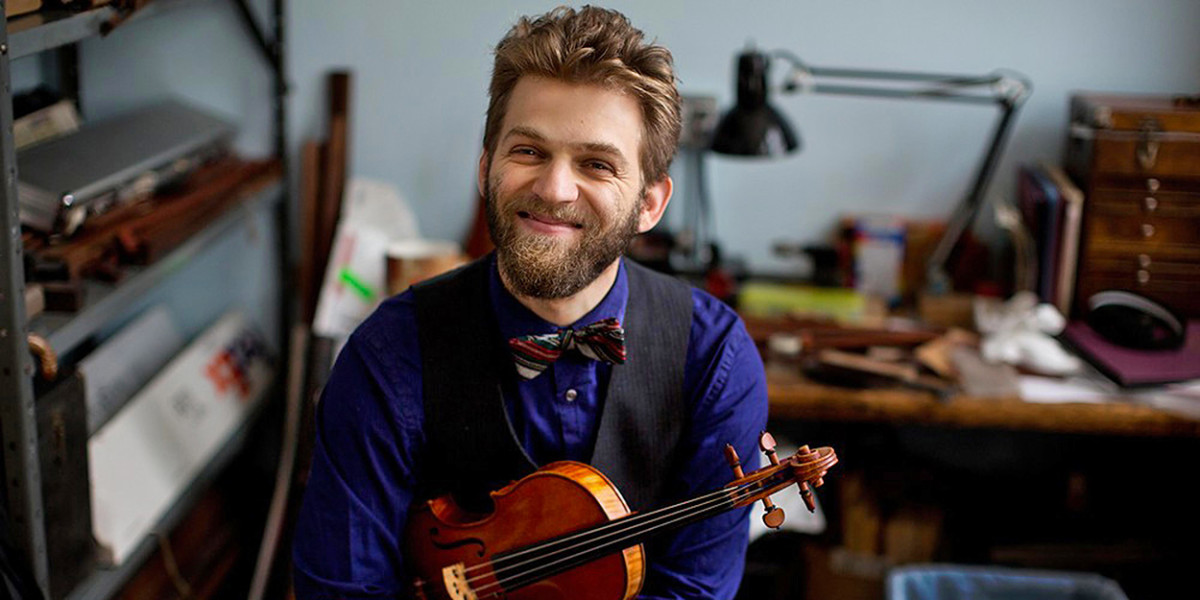Johann Sebastian Bach’s Sonatas and Partitas for solo violin are Shakespearian in their iconicity. Every serious performer must subject them to study, memorizing a monologue or, in this case, a movement, tracing and retracing the familiar, fleet-footed phrases in the hopes that something of their magic will rub off. Yet only the greats are remembered for their renditions.
On October 30, 2015 at MIT Kresge Auditorium in Cambridge, the violinist Johnny Gandelsman will perform the Sonatas and Partitas in their entirety as part of MIT’s Sounding Series in the first annual Terry and Rick Stone Concert. It may come as some surprise that Gandelsman has chosen to tackle Bach’s famed violin cycle, which was completed in 1720. The Moscow-born Gandelsman has long eschewed the trappings of a traditional classical career, preferring instead to stake his reputation on his work with the genre-averse string quartet Brooklyn Rider and Yo-Yo Ma’s globally adventurous Silk Road Ensemble. According to Gandelsman, who worked in a wine shop for four years to support himself after graduating from the Curtis Institute of Music in Philadelphia, such a path is not uncommon for today’s young classical musicians. “I followed my interests, people and things that really excited me,” he says simply. The attitude has paid off; thanks to those projects, Gandelsman has had the opportunity to work with artists as diverse as the banjo virtuoso Bela Fleck and the rockstar Bono.
The Sonatas and Partitas came to Gandelsman as a kind of challenge: in 2013, the Helicon Foundation invited him to perform the Chaconne from Partita No. 2 in D Minor, under the condition that he play on gut strings with a Baroque bow. The experience was so transformative that Gandelsman has made the complete cycle a regular part of his repertoire, though he now performs it on a modern instrument.
The trend towards “authentic” renditions of Baroque music has caught on in recent years, and although Gandelsman is not a devotee of this historically-minded approach, some of its thinking has nevertheless inflected his interpretation. Baroque violin bows tend to be lighter than their modern counterparts, and weighted towards the frog, lending a rhythmic pulse to every downward stroke. They perform with particular clarity and liveliness in passages of quick, separate notes. “When I started using a Baroque bow, many phrase-related things became clear,” says Gandelsman. “Tempos, written-out improvisations, voice leading—a Baroque bow suggests both possibilities and limitations that are refreshing and inspired me to dig further.”
Yet it may be Gandelsman’s numerous brushes with folk music, thanks to his work with both Brooklyn Rider and the Silk Road Ensemble, that have had the deepest impact on his playing.
“Both groups have explored music from around the world, often music that is either straight-up folk music, or music that is deeply inspired by folk traditions,” says Gandelsman. “Dance, groove, melody and improvisation are all so important in folk music. I look for those things in Bach’s score, particularly in the Partitas. Imagining someone dancing to a Sarabande is no longer abstract—I can hear and feel the steps one would need to make.” In particular, “working with the wonderful Irish fiddler Martin Hayes has opened my ears to more of a folk music path in some of the movements in the Partitas.”
In the Sonatas and Partitas for solo violin, Gandelsman employs vibrato sparingly. Like Hayes, he possesses a translucent tone and a delicate touch. He is expressive in the manner of a classical violinist, stretching certain phrases for dramatic effect and lingering momentarily to let the occasional note shine. But he errs towards understatement, preferring modesty to melodrama. Gandelsman says that he tried to remain uninfluenced by other performances of the cycle. “I find it hard to listen to recordings: the better they are, the harder it is to quiet them in my head while searching for my own interpretation.” And indeed he seems weightless at times, unencumbered by the burdens of history in his nimble perambulations through the past.

